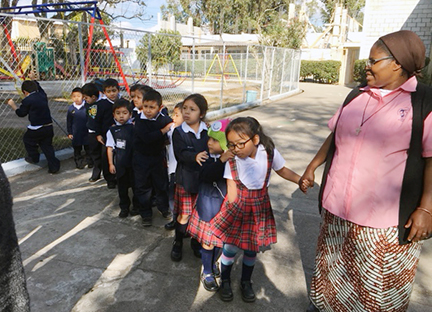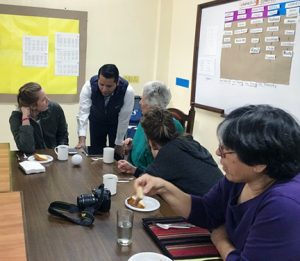Sister Community Committee for Guatemala Gives Trip Report
Posted on March 1, 2018, by Irma Avila SL

Photo courtesy of Mary Ann McGivern
On Jan. 22, Mary Ann McGivern, Connie Newton and I went to La Escuela Sagrada Familia – Zona 10 in Guatemala City, Guatemala. During our visit, we shared the reality of that school.
The Sisters of the Holy Family who are directly involved with the school and live in community there are Elena, Odilia, Regine (from the Congo), Rosario A. and Rosario R. Representatives from each academic level were invited to speak with us. Aura Marina, Jarod, Laura, Lesley and María Belen each shared about their multiple responsibilities. It was much like the administrators, faculty and staff of our own schools do. The similarity of mission and dedication was not surprising to me.

Connie, Raegen and Micki returned to the Academia Belga to meet with Rudy’s sister-in-law who could facilitate access to the Escuela’s computer lab. They left the necessary items with Rudy to be processed later – a very positive intercommunity outcome of the trip to Guatemala.
Photo by Mary Ann McGivern
This particular school has counted on the support of the Colegio Belga, generous donors and external support. The school is constructing four new classrooms and has added new courses of study while at the same time recognizing the need for higher academic status and higher levels of study. They wish to provide the technological tools that can open doors of opportunity to the students, giving them access to another mode of life – higher education and successful careers.
Much like in the United States, the number of students is often less than what the sisters would hope. Many of the students are children or family members of alumni. The situation allows for familiarity, with a process that brings those who are known and trusted, and who also may have limited resources, to the collaborative effort. Parents strive to give values, faith/spirituality and a quality education to their children. As might be expected, scholarships and English instruction are needed.
The administrators, faculty and staff are dedicated to offering their very best. If the first month’s tuition can’t be paid, students are not dismissed; instead, plans are negotiated. Because the school exists as part of the municipality, tuition remains fixed at 250 quetzals per month ($30.06 U.S.) no matter the rising costs.
The school promotes good nutrition. Since there is no cafeteria and students are there from 8 a.m. to 1 p.m., they are encouraged to have breakfast at home. They bring snacks for recess period, or snacks are sold at the school. There is a general sense of shared care and concern, which creates a healthy environment in terms of the absence of gangs, no attempts at extortion, no bullying and respect being modeled.
While technology is important, most of the students do not have cell phones, tablets or computers at home. Another difficulty is that both parents work full time, leaving the young students to care for each other inside their homes. Being outside is as dangerous as we know it can be in the United States.
Some concerns involve the self-financing of the school, encouraging everyone to add their part, the distances that students are traveling (through the heavily commercialized surrounding area), walking and crossing busy intersections, and the conditions in which many of the students live, suffering cold and having to warm their shoes in the oven. There are a few students who rise at 3 a.m. to ride on horseback to catch a bus to arrive on time. I experienced the dangers when I slid down a cliffside with Rosario R. and a young student who makes the trek with a younger sister. The family lives in the valley next to a contaminated, trash-strewn river, which is the laundry facility.
We asked whether links with businesses and corporations would be helpful in terms of internships and good employment. Though helpful, it seems not to be possible. Here in the United States we also feel the lack of governmental funding for education.
It is my hope that Loretto Academy, Nerinx Hall and St. Mary’s Academy continue to be a source of support for the schools of the Holy Family Sisters in Guatemala.
Such support, which includes the FST Sisters in Ghana and our own in Pakistan, Marian Middle School or Havern at the Denver Center, is invaluable.
Raegen Rychecky, a St. Mary’s Academy student, at left, explains the workings of a robot program she brought to share with Rudy, an Escuela Sagrada Familia-Zona 10 teacher. Listening are Connie Newton, Raegen’s mom, Micki, and Irma Avila.
Connie, Raegen and Micki returned to the Academia Belga to meet with Rudy’s sister-in-law who could facilitate access to the Escuela’s computer lab. They left the necessary items with Rudy to be processed later – a very positive intercommunity outcome of the trip to Guatemala.
